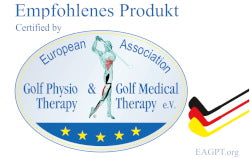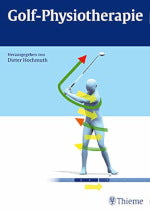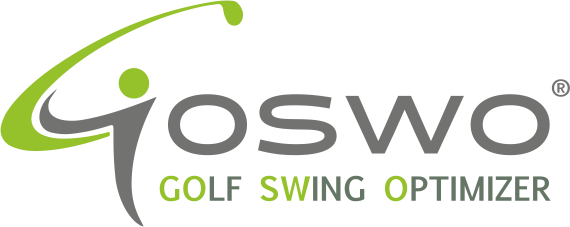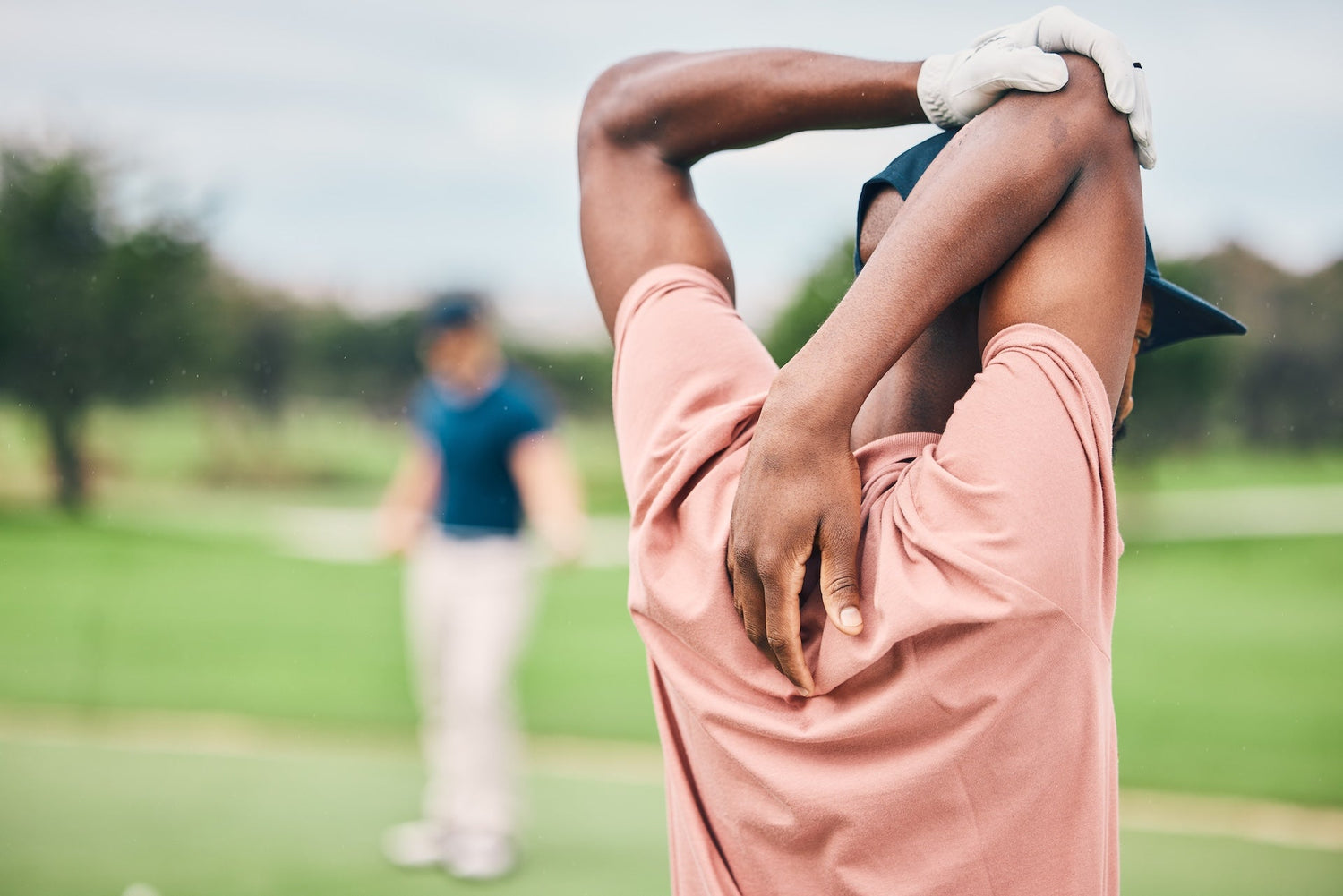Avoiding golf injuries - use of sensible training aids
The golf swing is characterized by extreme torso rotation with an almost constant forward leaning of the upper body. A high speed of movement is required for a good swing result and the golfer must coordinate asymmetrical muscle activities into a harmonious movement.
This coordination is lacking, especially for beginners, so that instead of regularity, timing and precision, the focus is primarily on the use of strength. Incorrect, jerky and cramped movements lead very quickly or even immediately to pain and thus to injury and can therefore be identified very easily as the cause of complaints. This is different with the insidious damage caused by overuse, which only sets in after weeks and months as a result of a bad golf swing.
According to a representative survey , 70 percent of all golfers surveyed have suffered at least one sports injury. The most common injuries were in the elbow, shoulder, wrist and lumbar spine.
GOSWO - correct movement on the correct swing plane
A great many injuries ultimately stem from a swing motion on the wrong swing plane. Injuries of all kinds, which are often caused by a "baseball swing" or an excessively strong "outside-in swing", are thus avoided. First and foremost are knee injuries and injuries to the lumbar spine. Through a predetermined swing corridor, the golfer trains the correct movement, which automatically leads to straight and wider shots. A wrong execution of the swing is therefore almost impossible.

Recommended Product Certification
After careful examination and taking into account golf-related health aspects from the point of view of the individually biomechanically optimized golf swing, we received the certification "recommended product" for GOSWO from the European Association GolfPhysioTherapy & GolfMedicalTherapy eV. The purpose of the association is to promote public health care in the sport of golf . The focus of the work is on prevention in children and young people and on support, especially in the case of physical disabilities. The EAGPT takes into account the latest golf physiotherapeutic findings. Another important target group of the EAGPT are senior citizens . The club's credo is: Ergonomic golfing with an individual, biomechanically optimized golf swing.
With GOSWO, creeping damage from overuse caused by a bad golf swing can be avoided. Therefore, we attach great importance to prevention in children and young people. Another target group are senior citizens and golfers. We are happy to inform you about the experiences in senior golf .
We have also gained experience in handicapped golf in different handicap classes. We are happy to provide you with references, but we do not want to publish all of them. In blind golf we also have the opinion of experienced golfers such as B. Ivars Weise (multiple European champion in blind golf) and Karin Becker (multiple national champion from Austria). "GOSWO is the perfect training device for the golf swing on the correct swing plane".
ROTATIX - At the start of each round of golf and 5 minutes daily
To prevent injury, warming up before you start playing golf is crucial. During the golf swing, the necessary tendons and muscles are extremely stressed. However, this stress is not perceived as strenuous by the golfer. Accordingly, the very important warm-up program is usually kept short or completely neglected. ROTATIX is a training device for stretching, stretching and tilting. Warming up and stretching exercises with ROTATIX not only serve to prevent injuries before each round of golf, but the exercises also lead to better coordination of the upper body and hips. The stretching exercises increase mobility and immediately create more rotational range. The result: more consistent and longer shots. But it's not enough just to stretch before the round. A few minutes a day bring lasting more mobility and lasting better golf – well into old age. Because the older we get, the more muscles and tendons shorten.
Over 80% of all golfers also bend their left knee inwards on the upswing (this has led to many surgeries at Tiger Woods). Correct training with ROTATIX eliminates this kink stress. In addition to Tiger Woods, many professional golfers have switched their swing to the Stack & Tilt golf swing. In this swing, the right hip is tilted up to the right on the upswing and the left hip is brought forward to the left. This completely eliminates buckling.
HMC FLEX STICKS - fewer injuries, more consistent hits, better golf
Over 90% of all golfers have been injured by hitting the ground too hard. These hits come about because the upper body “dives” on the downswing. But it is precisely this movement of the upper body and thus of the head that leads to badly hit balls. This “moving” can be observed in over 90% of all golfers. Moving is the most common reason for inconsistent hits in golf. Constant hits can only occur if the head is held in the same position from the upswing to the moment of impact. As long as this moving is present in a golfer, balls are topped or hit too fat. Training sessions at home for a few minutes a day do not help here. The older we get, the greater our susceptibility to injury. Daily training with ROTATIX in combination with HMC-FLEX-STICKS will significantly improve your game. - Guaranteed.
50+ golfers
A good half of all golfers are over 50. With increasing age, mobility becomes more restricted and the risk of injury increases. This is especially true for latecomers to golf. Every golfer achieves more mobility through targeted training with ROTATIX .
women golf
Compared to the men, the average female golfer hits the ball with less power and ambition because distance plays a subordinate role. But every second female golfer suffers lower back injuries. One in four female golfers suffers left elbow injuries. In women, injuries to the left wrist are also very common.
Overuse Damage and Disability
Exercising too often is more likely to lead to overuse injuries. This is more likely to be observed in younger, more ambitious beginners. However, injuries caused by excessive ground contact are much more common. Balls that are hit too fat usually result in injuries to the back or wrists. (Here training with HMC-FLEX-STICKS helps enormously)
Correct exercises with the physiotherapist
Most golf coaches don't care about a healthy golf swing. Otherwise, golf trainers would recommend useful training aids. To avoid health problems, the only thing that helps is constant practice with GOSWO, ROTATIX, HMC-FLEX-STICKS - ideally with a physiotherapist. Golf physiotherapy not only helps in the course of a golf injury, but can also preventively ensure that the golfer learns the best and healthiest golf swing right away.
In the event of previous damage, a physiotherapist should be consulted anyway.
In most cases, incorrect grip and swing techniques are responsible for the injuries. Therefore, every player should also take coaching lessons at regular intervals. Only a good trainer recommends appropriate training aids to his students and gives them “homework” to do. Problems that have been identified cannot be resolved in a training session. But practicing and rehearsing or internalizing the right exercise at home is the right way. – This is how it works with the children at school.
The golf coach knows that too. If he doesn't recommend training aids and doesn't give you "homework," you should question his training.
Correct and technically perfect implementation of the very complex movement sequences in a golf swing requires physical fitness and coordination skills. Accordingly, golf training is not only necessary on the course, but essentially also at home. This is the only way to strengthen the required muscle groups and avoid overloading.
In order to optimize the golf swing, biomechanical considerations were made, and since every golfer not only wants to be pain-free but also want to play well, criteria for optimized movement have already been worked out. These were developed in a collaboration between Dr. Christian Haid, head of the biomechanical laboratory in Innsbruck, and Dieter Hochmuth, who works as head of the courses for golf physio trainers (EAGPT).
You can read about it in the following publications by Dieter Hochmuth:
Golf Physiotherapy - ISBN: 9783132021112
Top Golf - ISBN: 9783981491821


